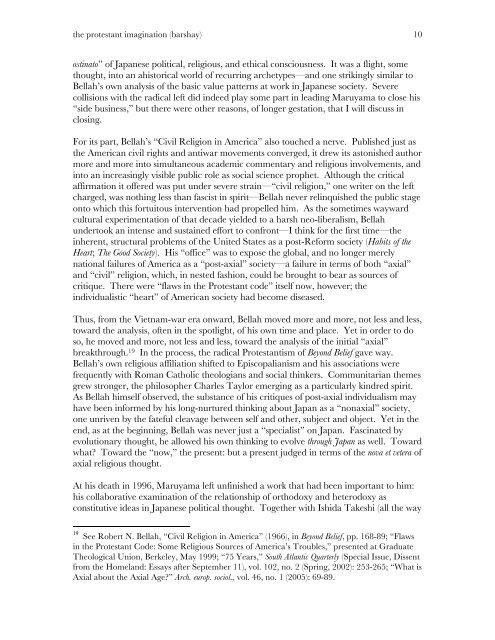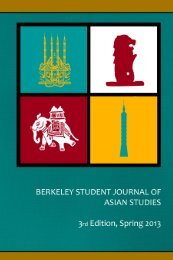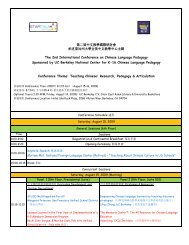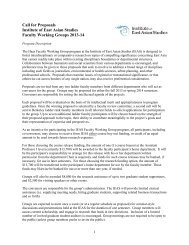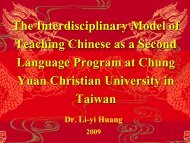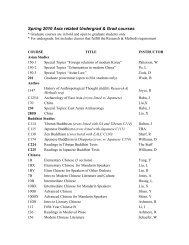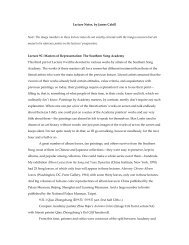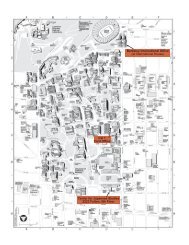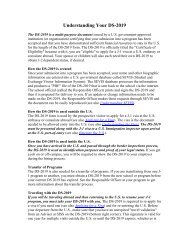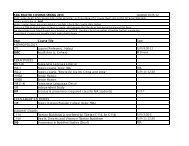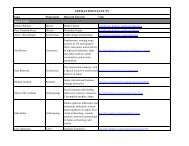short essay - Institute of East Asian Studies, UC Berkeley
short essay - Institute of East Asian Studies, UC Berkeley
short essay - Institute of East Asian Studies, UC Berkeley
- No tags were found...
You also want an ePaper? Increase the reach of your titles
YUMPU automatically turns print PDFs into web optimized ePapers that Google loves.
the protestant imagination (barshay) 10ostinato” <strong>of</strong> Japanese political, religious, and ethical consciousness. It was a flight, somethought, into an ahistorical world <strong>of</strong> recurring archetypes—and one strikingly similar toBellah’s own analysis <strong>of</strong> the basic value patterns at work in Japanese society. Severecollisions with the radical left did indeed play some part in leading Maruyama to close his“side business,” but there were other reasons, <strong>of</strong> longer gestation, that I will discuss inclosing.For its part, Bellah’s “Civil Religion in America” also touched a nerve. Published just asthe American civil rights and antiwar movements converged, it drew its astonished authormore and more into simultaneous academic commentary and religious involvements, andinto an increasingly visible public role as social science prophet. Although the criticalaffirmation it <strong>of</strong>fered was put under severe strain—“civil religion,” one writer on the leftcharged, was nothing less than fascist in spirit—Bellah never relinquished the public stageonto which this fortuitous intervention had propelled him. As the sometimes waywardcultural experimentation <strong>of</strong> that decade yielded to a harsh neo-liberalism, Bellahundertook an intense and sustained effort to confront—I think for the first time—theinherent, structural problems <strong>of</strong> the United States as a post-Reform society (Habits <strong>of</strong> theHeart; The Good Society). His “<strong>of</strong>fice” was to expose the global, and no longer merelynational failures <strong>of</strong> America as a “post-axial” society—a failure in terms <strong>of</strong> both “axial”and “civil” religion, which, in nested fashion, could be brought to bear as sources <strong>of</strong>critique. There were “flaws in the Protestant code” itself now, however; theindividualistic “heart” <strong>of</strong> American society had become diseased.Thus, from the Vietnam-war era onward, Bellah moved more and more, not less and less,toward the analysis, <strong>of</strong>ten in the spotlight, <strong>of</strong> his own time and place. Yet in order to doso, he moved and more, not less and less, toward the analysis <strong>of</strong> the initial “axial”breakthrough. 19 In the process, the radical Protestantism <strong>of</strong> Beyond Belief gave way.Bellah’s own religious affiliation shifted to Episcopalianism and his associations werefrequently with Roman Catholic theologians and social thinkers. Communitarian themesgrew stronger, the philosopher Charles Taylor emerging as a particularly kindred spirit.As Bellah himself observed, the substance <strong>of</strong> his critiques <strong>of</strong> post-axial individualism mayhave been informed by his long-nurtured thinking about Japan as a “nonaxial” society,one unriven by the fateful cleavage between self and other, subject and object. Yet in theend, as at the beginning, Bellah was never just a “specialist” on Japan. Fascinated byevolutionary thought, he allowed his own thinking to evolve through Japan as well. Towardwhat? Toward the “now,” the present: but a present judged in terms <strong>of</strong> the nova et vetera <strong>of</strong>axial religious thought.At his death in 1996, Maruyama left unfinished a work that had been important to him:his collaborative examination <strong>of</strong> the relationship <strong>of</strong> orthodoxy and heterodoxy asconstitutive ideas in Japanese political thought. Together with Ishida Takeshi (all the way19 See Robert N. Bellah, “Civil Religion in America” (1966), in Beyond Belief, pp. 168-89; “Flawsin the Protestant Code: Some Religious Sources <strong>of</strong> America’s Troubles,” presented at GraduateTheological Union, <strong>Berkeley</strong>, May 1999; “75 Years,” South Atlantic Quarterly (Special Issue, Dissentfrom the Homeland: Essays after September 11), vol. 102, no. 2 (Spring, 2002): 253-265; “What isAxial about the Axial Age?” Arch. europ. sociol., vol. 46, no. 1 (2005): 69-89.


